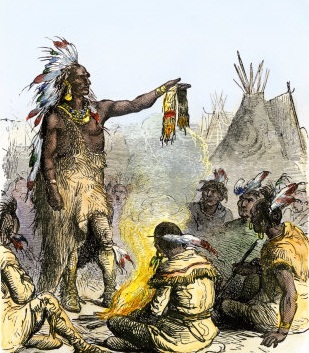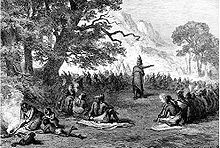| Pontiac or Obwandiyag (c. 1720 � April 20,
1769), was an
Ottawa leader who became famous for his role in
Pontiac's Rebellion (1763�1766), an
American Indian struggle against the
British military occupation of the
Great Lakes region following the British victory in the
French and Indian War. Historians disagree about
Pontiac's importance in the war that bears his name.
Nineteenth century accounts portrayed him as the mastermind
and leader of the revolt, while some subsequent
interpretations have depicted him as a local leader with
limited overall influence. The war began in May 1763 when Pontiac and 300 followers attempted to take Fort Detroit by surprise. His plan foiled, Pontiac laid siege to the fort, and was eventually joined by more than 900 warriors from a half-dozen tribes. Meanwhile, messengers spread the word of Pontiac's actions, and the war expanded far beyond Detroit. In July 1763, Pontiac defeated a British detachment at the Battle of Bloody Run, but he was unable to capture the fort. In October he lifted the siege and withdrew to the Illinois country. Although Pontiac's influence had declined around Detroit because of the unsuccessful siege, he gained stature in the Illinois and Wabash country as he continued to encourage resistance to the British. Seeking to end the war, British officials made Pontiac the focus of their diplomatic efforts. In July 1766, Pontiac made peace with British Superintendent of Indian Affairs Sir William Johnson. The attention which the British paid to Pontiac created resentment among other Indian leaders, particularly because Pontiac claimed far greater authority than he actually possessed. Increasingly ostracized, in 1769 he was assassinated by a Peoria Indian.
Early yearsThere is little reliable information about Pontiac before the war of 1763. He was probably born between 1712 and 1725, perhaps at an Odowa village on the Detroit or Maumee Rivers.[2] The tribal affiliation of his parents is uncertain. According to an 18th century Odowa tradition, Pontiac's father was an Odowa and his mother an Ojibwa, although other traditions maintained that one of his parents was a Miami. Pontiac was always identified as an Odowa by his contemporaries.[3] Pontiac was an Ottawa war leader by 1747, when he allied himself with New France against a resistance movement led by Nicholas Orontony, a Huron leader.[4] Pontiac continued to support the French during the French and Indian War (1754�1763). Although there is no direct evidence, he possibly took part in the famous French and Indian victory over the Braddock expedition on July 9, 1755.[5] In one of the earliest accounts of Pontiac, the famous British frontier soldier Robert Rogers claimed to have met with Pontiac in 1760; historians now consider Rogers's story to be unreliable.[6] Rogers wrote a play about Pontiac in 1765 called Ponteach: or the Savages of America, which helped to make Pontiac famous and began the process of mythologizing the Ottawa leader.[7] Siege of Detroit
Main articles:
Pontiac's Rebellion and
Siege of Fort Detroit
After the French and Indian War, Native American allies of the defeated French found themselves increasingly dissatisfied with the trading practices of the victorious British. The architect of British Indian policy, General Jeffrey Amherst, decided to cut back on the provisions customarily distributed to the Indians from the various forts, which he considered to be bribes. A fur trader, Normand Macleod, heard Pontiac was accepting ten shillings a day from the British, which inspired resentment from other Indian leaders.[8] Additionally, the French had made gunpowder and ammunition readily available, which were needed by the Indians to hunt food for their families and skins for trade. However, Amherst did not trust his former Indian adversaries, and restricted the distribution of gunpowder and ammunition. Pontiac, like other Indian leaders, was unhappy with the new British policies. Taking advantage of this dissatisfaction, as well as a religious revival inspired by a Lenape prophet named Neolin, Pontiac planned a resistance. He hoped to drive British soldiers and settlers away, and to revive the valued French and Indian alliance. On April 27, 1763, he held a large council about 10 miles below Fort Detroit (present-day Council Point Park in Lincoln Park, Michigan). Pontiac urged the listeners to join him in a surprise attack on Fort Detroit. On May 1, Pontiac visited the fort with 50 Ottawas in order to assess the strength of the garrison.[9] According to a French chronicler, in a second council Pontiac proclaimed:
Widespread attacks against British forts and Anglo-American (but not French) settlements in the Ohio Country soon followed. The degree to which Pontiac personally influenced events beyond the Detroit region has been variously interpreted. Older accounts of the war portrayed Pontiac as a savage but brilliant mastermind behind a massive "conspiracy" which was planned in advance. Historians today generally agree that Pontiac's actions at Detroit were the spark that instigated the widespread uprising, and that he helped to spread the resistance by sending emissaries urging others to join the resistance, but Pontiac did not command the uprising as a whole. Native leaders around Fort Pitt and Fort Niagara, for example, had long been calling for resistance to the British and were not led by Pontiac. According to historian John Sugden, Pontiac "was neither the originator nor the strategist of the rebellion, but he kindled it by daring to act, and his early successes, ambition, and determination won him a temporary prominence not enjoyed by any of the other Indian leaders."[11] Later yearsAfter the failure to capture Fort Detroit in 1763, Pontiac withdrew to the Illinois Country, where he continued to encourage militant resistance to British occupation. Although the British had successfully pacified the uprising in the Ohio Country, British military dominance was tenuous, and they decided to negotiate with the Ottawa leader. Pontiac met with the British superintendent of Indian affairs Sir William Johnson on July 25, 1766, at Oswego, New York, and formally ended hostilities. This attention paid to Pontiac by the British Crown encouraged him to assert more power among the Indians of the region than he actually possessed. Local rivalries flared up, and in 1768 he was forced to leave his Ottawa village on the Maumee River. Returning to the Illinois Country, Pontiac was murdered on April 20, 1769, at the French village of Cahokia (nearly opposite St. Louis, Missouri) by a Peoria Indian, perhaps in retaliation for an earlier attack by Pontiac. Various rumors quickly spread about the circumstances of Pontiac's death, including one that the British had hired his assassin. According to a story recorded by historian Francis Parkman in The Conspiracy of Pontiac (1851), a terrible war of retaliation against the Peorias resulted from Pontiac's murder. Although this legend is still sometimes repeated, there is no evidence that there were any reprisals for Pontiac's murder.[12] Pontiac's burial place is unknown, and may have been at Cahokia, but evidence and tradition suggest that he was buried in St. Louis. In 1900, a plaque was mounted in a hallway of the Southern Hotel, which had been built over the reputed gravesite in 1890.[13] The city of Pontiac, Michigan was named for him, as well as the town of Pontiac, Illinois and a region/municipality bordering the Ottawa River in the province of Quebec. Pontiac was also the name of a popular General Motors automobile brand, discontinued in 2010. Notes
References
O'Toole, Fintan. White savage: William Johnson and the invention of America. New York: Farrar, Straus and Giroux, 2005
Further reading
|



